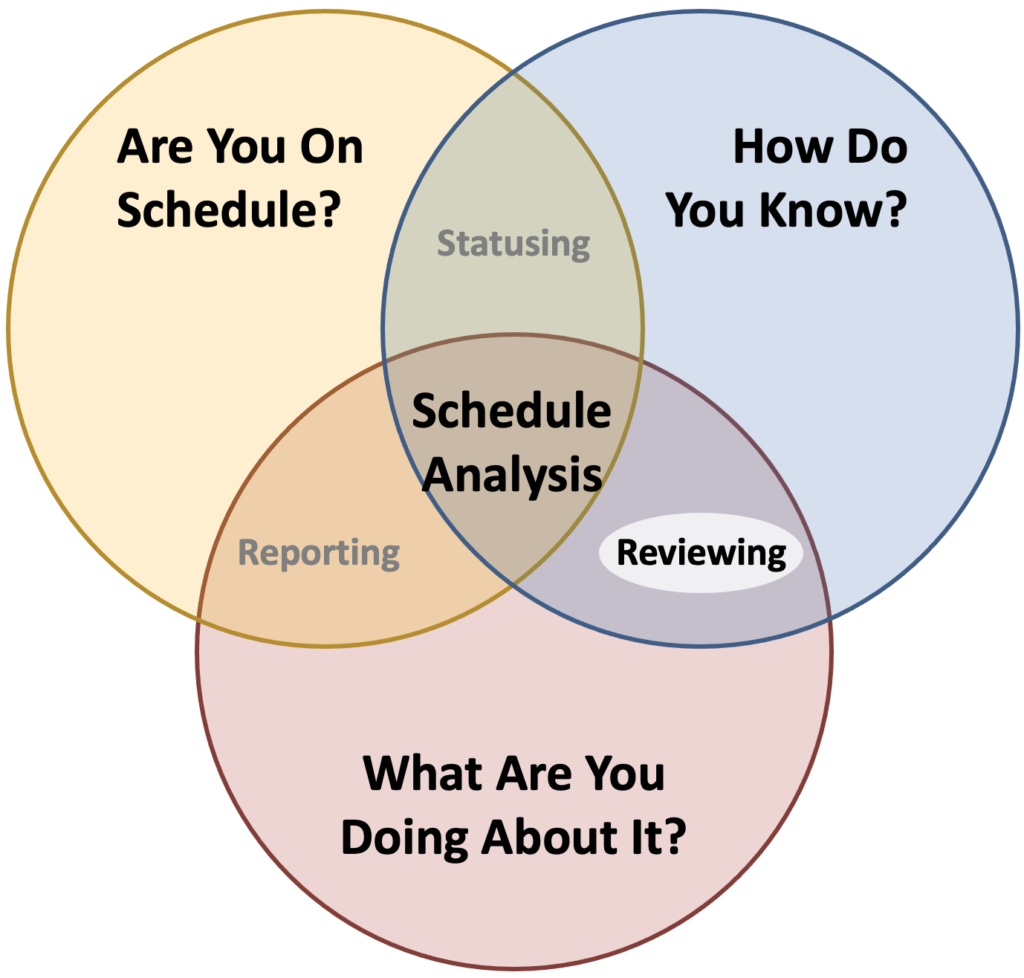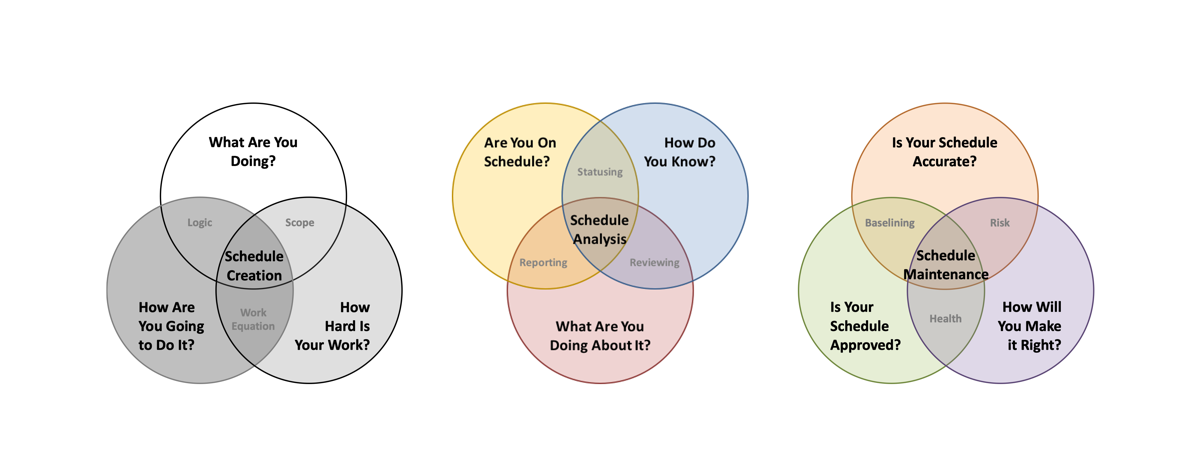
Are you on schedule? Most of the work week is spent preparing to ask this quintessential question or dealing with the answer. But here in the middle, the Schedule Manager assumes their unique ability and responsibility to forecast the project’s future.
This article will introduce the concept of individual and manager schedule reviews, and how to leverage the schedule file to make the most productive use of review meetings.
Individual Reviews
The individual review is the Schedule Manager’s opportunity to get reacquainted with the schedule, reviewing current and upcoming tasks with a fresh set of eyes. The individual review’s end goal is to identify which schedule shifts are real, and which lines in the schedule and resource workloads require attention. Conducting the individual review in layers will help a Schedule Manager efficiently reabsorb the schedule’s large quantity of data.
The first pass through the schedule should look at summary level activities, key milestones, and events which would impact the project if they shifted. It’s usually too early to make any corrections. The first pass is more about identifying where to concentrate this week’s analysis.
The second pass looks for artificial delays and digital artifacts which disrupt the schedule logic. Sweeping incomplete work forward after statusing the schedule is a powerful method for keeping the schedule up to date, but sometimes schedule management applications can overcorrect. Level of effort tasks such as on call technical support and project management overhead commonly need to be pulled back. Tasks which have uncommon logic or special working hours may also get pushed too far to the right. These false positives are fixed as they are found, and typically do not need input from team leads to correct.
The third pass through the schedule concentrates on schedule health, especially issues which impact the accurate forecasting of finish dates. Look out for missing dependencies, or tasks with schedule logic that is no longer applicable. Tasks that are over constrained or have negative slack should also be repaired.
After proofreading the schedule to ensure its data represents the project’s progress, the final pass scrutinizes the schedule for task and workload variance which need the team leads’ attention. For the Schedule Manager’s own sake, this analysis should be meticulous. What is the technical mechanism causing a given line item to shift? Is it the remaining work? Is it a preceding line item or a date constraint? Is it a non-working period such as a holiday? The individual review also prepares the schedule and the Schedule Manager for the group reviews. It is often handy to highlight specific lines and fields in the schedule that must be examined, or to make notes for facilitating discussion.
The individual review, even of very large schedules, should take at most an hour. Individual reviews that consistently take longer might indicate that the wrong details are being scrutinized. As was touched upon in Schedule Analysis Techniques, only a small number of line items can impact the schedule at any given time. Schedule Reviewing Techniques will explore how even the largest schedules can be parsed to quickly find and fix hotspots.

Manager Reviews
Schedule review meetings are working meetings. Both the schedule file, and the manager’s plan for the week will be altered during the meeting. Manager reviews are also a natural source of tension. The schedule is a communications channel to all levels of project leadership, which puts “bad news” on public display. Falsely attributing schedule slip to poor performance is a misconception which the best run programs learn to get over. The Schedule Manager can play an essential part in creating this culture shift.
Managers hate wasting time on recurring chores. Even the most enthusiastic participants are best served when review meetings are conducted with all possible speed and efficiency. Both challenges can be met by properly preparing for the manager reviews during the individual review and conducting the schedule reviews with the smallest number of participants. One-on-one meetings are ideal.
The principal advantage to holding multiple small review meetings is that managers do not waste time covering parts of the schedule that do not concern them. For example, suppose a large project schedule tracks the work of six different project teams. Assuming a schedule review takes twenty minutes for each team’s section, the Schedule Manager will spend two hours reviewing the schedule file. If the Schedule Manager reviews the entire schedule in one large meeting, each team lead will be actively engaged for only twenty minutes and twiddling their thumbs the rest of the time.
Schedule Analysis Principles introduced the case for meeting with managers weekly. Reviewing the schedule at frequent intervals will result in fewer and smaller course corrections each meeting. Meeting weekly will also keep the urgency of any given meeting low. This again is a benefit to managers who have enough urgent matters during the week. The more frequently Schedule Managers and team leads take time to meet, the less essential, and less time consuming any single meeting becomes. Many schedule review meetings when held weekly, can be held in only half an hour. This lets the team lead slot their meeting almost anywhere they have opening in their calendar. Rescheduling the meeting to work around the manager’s unpredictable schedule is easy if the manager is the only meeting participant.
Meeting Prep
An experienced Schedule Manager needs only minutes to get the schedule ready for a meeting with a manager.1That is, after the prep work done during the statusing and the individual review. It is a good idea to do the following steps before the meeting starts.
- Close any files and applications not relevant to the meeting.
- Create a backup copy of the schedule.
- Open the schedule to the section where you want to begin.
- Filter the schedule to show only the lines relevant to this meeting.
- Set up any displays, conference lines, or screen shares.
This minute professional courtesy sets a positive expectation for managers and kicks off the meeting with a boost in patience rather than a deficit. No matter how much floundering ensues, the meeting will start clean and under control.
Meeting Format
Every schedule review meeting with every team lead should follow the same format. Consistency breeds comfort which breeds trust. Start by reviewing the manager’s current and upcoming tasks. A good way to focus the manager’s attention is to filter the schedule such that only their tasks which are incomplete, or recently complete are visible. Then begin reviewing the schedule from the top, going line by line. Spend a moment reviewing the newly complete line items, even just to acknowledge they are done. The manager won’t mind taking an extra moment to recognize a few small wins. Occasionally this uncovers a task or a milestone which has been marked complete prematurely. This happens occasionally, and when they are caught early, it can prevent substantial disruption.

Once all the tasks have been reviewed, and any variances adjudicated, switch to a resource view of the schedule, so that the team lead can see how much work their teams have in the coming weeks. Properly resource loading a schedule file is a substantial time investment with a high payoff.

Resource Overloads are excellent indicator of when work is expected to slip. For example, in Figure 27 John, Jacob, and Abagail’s workloads the week of December 14th are not completable in a 40-hour work week, especially amid holidays. But with several weeks warning, the manager has ample opportunity to decide how to triage the team’s work. It may take managers a couple iterations to find the best tradeoff between deadlines and workloads. This is time well spent when the manager ends up with a better (or at least more informed) plan forward than what they started the meeting with.
Last, the Schedule Manager should review new work that the team is planning but is not yet on the schedule. Large or urgent additions to the schedule may require a separate meeting to review. But if time allows, the recurring schedule review meeting is an ideal opportunity to vet draft schedule “fragnets” in preparation for approval, and incorporation into the schedule file.
Next Steps
Schedule reviews are meetings, and much of their effectiveness has nothing to do with the schedule. The great meeting strategies and guidebooks written since the Industrial Revolution will help you build lasting project relationships by making the most of this valuable time. But the schedule’s power as a communication tool distinguishes schedule reviews from most ordinary project meetings. Schedule Reviewing Principles will delve into the unique relationship between Schedule Manager and team lead, and the keys to making schedule review meetings effective.
